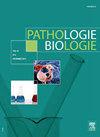引用次数: 0
摘要
哺乳动物表皮颗粒层的细胞含有密集的染色体,称为角透明素颗粒。确定了两种类型的颗粒。较大的细胞含有磷,主要由一种异常丰富的组氨酸蛋白质组成。这种蛋白质分子量高,含有大量碱性氨基酸。然而,由于广泛的磷酸化,它具有中性等电点。这种富含组氨酸的蛋白在终末分化过程中发生修饰,特别是当颗粒细胞分化为覆盖的角化细胞时,角透明素颗粒分散时。此时,它被去磷酸化和部分蛋白水解,形成低分子量、高碱性、富含组氨酸的蛋白质。这些阳离子分子在体外与角蛋白中间丝聚集,形成有序的大原纤维,其结构类似于在较低的角蛋白层中看到的角蛋白模式。由于这个原因,这些蛋白质被称为聚丝蛋白。高分子量前体称为侧聚蛋白。聚丝蛋白是物种特有的产物,由许多等电变体组成。聚丝蛋白前体是由串联连接的多拷贝聚丝蛋白结构域组成的,这些结构域散布着短连接肽。对聚丝蛋白提出了两个功能。第一种,基于它在体外与角蛋白纤维的相互作用,是在角质层下层形成纤维间基质。第二种方法是产生游离氨基酸及其衍生物的浓缩池,使角质层在低环境湿度下保持水分。这些函数表示顺序而非可选的角色。表皮疾病和体外培养表明表皮角化和分化与富组氨酸蛋白途径之间存在明确的关系。本文章由计算机程序翻译,如有差异,请以英文原文为准。
[Filaggrin].
Cells in the granular layer of mammalian epidermis contain densely staining bodies called keratohyalin granules. Two types of granules are identified. Larger ones contain phosphorus and consist largely of an unusually histidine rich protein. This protein has a high molecular weight and contains a large fraction of basic aminoacids. However it has a neutral isoelectric point due to extensive phosphorylations. This histidine rich protein undergoes modifications during terminal differentiation, especially when the keratohyalin granules disperse as the granular cells differentiate into the overlying cornified cells. At this point it is dephosphorylated and partially proteolyzed to form lower molecular weight highly basic histidine rich proteins. These cationic molecules aggregate in vitro with keratin intermediate filaments, forming well ordered macrofibrils whose structure resembles the keratin pattern seen in the lower cornified layers. For this reason the name filaggrin is used for these proteins. The high molecular weight precursor is called profilaggrin. Filaggrins are species-distinct products and consist of a number of isoelectric variants. It is established that the filaggrin precursor is composed of tandemly linked multiple copies of filaggrin domains interspersed with short linker peptides. Two functions are proposed for the filaggrin. The first one, based on its interaction with keratin fibres in vitro, is to form the interfilamentous matrix seen in the lower stratum corneum. The second one is to generate a concentrated pool of free aminoacids and derivatives, allowing the stratum corneum to remain hydrated at low environmental humidities. These functions represent sequential rather alternative roles. Epidermal diseases and in vitro cultures illustrate the clear-cut relations between epidermal keratinization and differentiation and the histidine rich proteins pathway.
求助全文
通过发布文献求助,成功后即可免费获取论文全文。
去求助

 求助内容:
求助内容: 应助结果提醒方式:
应助结果提醒方式:


